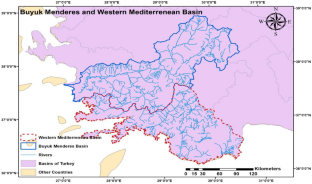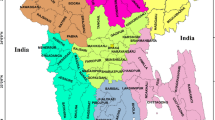Abstract
Hydroelectricity, which is defined as green energy, is a type of renewable energy. Despite the advantages of hydroelectric power plants, there are also negative effects caused by them. While power plants do provide advantages such as flood reduction, disaster management, mitigation of the effects of global warming and climate change; they can also lead to some unwanted environmental effects at the local and regional levels. In this study, the generation capacities of hydroelectric power plants that were built and commissioned by a Public Institution or by the Private Sector in the Büyük Menderes and Western Mediterranean basins were evaluated, for the years of 2010–2019. In the years examined, the project energy production value was compared with the maximum and minimum energy production levels of the power plants. The average maximum and average minimum production rates, which were calculated by proportioning the maximum and minimum energy production values to the project production value, was 93.33% and 56.04% for the West Mediterranean basin, respectively; and it was 92.97% and 43.09% for the Büyük Menderes basin. The average production rate for the Western Mediterranean basin was 69.8%, and for the Büyük Menderes basin it was 68%. It has been shown that there were significant differences between the annual energy production of the power plants and the amount of production realized due to the changes in the water resources of the studied basins, as well as due to insufficient data and careless planning. In addition, the production and environmental problems encountered during the operation phase have been revealed and suggestions have been recommended for the resolution of these problems in this study.







Similar content being viewed by others
References
Abbasi T, Abbasi SA (2011a) Small hydro and the environmental implications of its extensive utilization. Renew Sust Energ Rev 15(4):2134–2143
Abbasi T, Abbasi SA (2011b) Small hydro and the environmental implications of its extensive utilization. Renew Sustain Energy Rev 15:2134–2143
Anderson D, Moggridge H, Warren P, Shucksmith J (2015) The impacts of ‘run-of-river’ hydropower on the physical and ecological condition of rivers. Water Environ J 29:268–276
Avcı I (2008) Goals, expectations and realities in the practice. New global perspectives in the assessment and management of hydroelectric potential and water, a strategic resource in Turkey. Union of Chambers of Turkish Engineers and Architects, Journal of Measure, January 42–42. (in Turkish)
Bayazıt Y, Bakış R, Koç C (2017) An investigation of small scale hydropower plants using the geographic information system. Renew Sustain Energy Rev 67:289–294
Bayazıt Y, Bakış R, Koç C (2021) A study on transformation of multi-purpose dams into pumped storage hydroelectric power plants by using GIS model. Int J Green Energy 18(3):308–318
Bunn SE, Arthington AH (2002) Basic principles and ecological consequences of altered flow regimes for aquatic biodiversity. Environ Manag 30:492–507
Cejka T, Beracko P, Matecny I (2019) The impact of the Gabcikovo hydroelectric power barrier on the Danube floodplain environment-the results of long-term monitoring of land snail fauna. Environ Monit Assess 192:30
Couto TBA, Olden JD (2018) Global proliferation of small hydropower plants—science and policy. Front Ecol Environ 16:91–100
Dogmus ÖC, Nielsen JO (2020) The on-paper hydropower boom: a case study of corruption in the hydropower sector in Bosnia and Herzegovina. Ecol Econ 172:106630
DSI (2019) Büyük Menderes ve Batı Akdeniz Havzalarında İşletilen Hidroelektrik Santral Kayıtları, Tarım ve Orman Bakanlığı, DSİ Genel Müdürlüğü, DSİ 21. Bölge Müdürlüğü, İşletme ve Bakım Şube Müdürlüğü, Aydın
DSI (2020) http://www.dsi.gov.tr/english/service/enerjie.htm. Accessed 20 Apr 2020
EC (European Commission) (2000) Directive 2000/60/EC of the European Parliament and of the Council of 23 October 2000 establishing a framework for Community action in the field of water policy. Off J Eur Communities L 327:1–73
EC (European Commission) (2018) Commission E. Guidance document on the requirements for hydropower in relation to EU nature legislation. In: Environment, editor. Brussels, Belgium, p 1–83
Erlewein A (2013) Disappearing rivers—the limits of environmental assessment for hydropower in India. Environ Impact Assess Rev 43:135–143
ESHA (2010) Hydropower and environment, technical and operational procedures to better integrate small hydropower plants in the environment. http://www.esha.be. Accessed Oct 2010
EÜAŞ (2008) Özel Sektörün Hidrolik Santral Yapma A¸samaları. Elektrik Üretim Anonim Sirketi. http://www.euas.gov.tr/. Accessed 12 May 2020
EUROSTAT (2019) Energy statistics introduced. https://ec.europa.eu/eurostat/statistics-explained/index.php?title=Energy_statistics_introduced#Introduction. Accessed 1 May 2020
ICOLD (2000) Open letter to WCD Chair, 30 November 2000. International Commission on Large Dams
IHA (International Hydropower Association) (2019) Hydropower downstream flow regimes. International Hydropower Association, London, p 73
Kallis G, Butler D (2001) The EU water framework directive: measures and implications. Water Policy 3:125–142
Kelly S (2019) Megawatts mask impacts: small hydropower and knowledge politics in the Puelwillimapu, Southern Chile. Energy Res Soc Sci 54:224–235
Kelly-Richards S, Silber-Coats N, Crootof A, Tecklin D, Bauer C (2017) Governing the transition to renewable energy: a review of impacts and policy issues in the small hydropower boom. Energy Policy 101:251–264
Kentel E, Alp E (2013) Hydropower in Turkey: economical, social and environmental aspects and legal challenges. Environ Sci Policy 31:34–43
Koç C (2012) Problems and solutions related to hydroelectric power plants constructed on the Buyuk Menderes and the West Mediterranean basin. Energy Sources Part A Recov Util Environ Effects 34(15):1416–1425
Koç C (2014) A study on the development of hydropower potential in Turkey. Renew Sustain Energy Rev 39:498–508
Koç C (2017) A study on importance and role of irrigation and hydropower plant operation in integrated river basin management. Comput Water Energy Environ Eng 6:1–10
Koç C (2018) A study on operation problems of hydropower plants integrated with irrigation schemes operated in Turkey. Int J Green Energy 15(2):129–135
Koç C (2020a) A study on environmental and social impacts of mini hydro power plants. Eu J Sci Technol 20:35–41
Koç C (2020b) A study on operation of hydroelectric power plants constructed on irrigation canal. Eur J Sci Technol 19:138–144
Koç C, Kosif K, Kızıltepe S, Özdemir K (2010) Büyük Menderes ve Batı Akdeniz Havzalarında İşletmede olan Taşkın Tesislerine Yapılan Müdahaleler Üzerine Bir Çalışma. II. Ulusal Taşkın Sempozyumu 22–24 Mart, Afyonkarahisar, 71–79
Koralay N, Kara O, Kezik U (2018) Effects of run-of-the-river hydropower plants on the surface water quality in the Solakli stream watershed, Northeastern Turkey. Water Environ J 32:412–421
Laguna M, Upadhyay D, Taylor S (2006) Flowing to the East: Small Hydro in developing countries, Renewable Energy World, pp 126–131
Lange K, Meier P, Trautwein C, Schmid M, Robinson CT, Weber C et al (2018) Basin-scale effects of small hydropower on biodiversity dynamics. Front Ecol Environ 16:397–404
Larinier M (2008) Fish passage experience at small-scale hydro-electric power plants in France. Hydrobiologia 609:97–108
Mbaka JG, Wanjiru M (2015) A global review of the downstream effects of small impoundments on stream habitat conditions and macroinvertebrates. Environ Rev 23:257–262
McManamay RA, Samu N, Kao SC, Bevelhimer MS, Hetrick SC (2015) A multi-scale spatial approach to address environmental effects of small hydropower development. Environ Manag 55:217–243
Nautiyal H, Goel V (2020) Sustainability assessment of hydropower projects. J Clean Prod 265:121661
Pascale G, Connors BM, Palen WJ (2017) Run-of-River hydropower and salmonids: potential effects and perspective on future research. Can J Fish Aquat Sci 74:1135–1149
Poff NL, Zimmerman JKH (2010) Ecological responses to altered flow regimes: a literature review to inform the science and management of environmental flows. Freshw Biol 55:194–205
Popescu VD, Munshaw RG, Shackelford N, Montesino Pouzols F, Dubman E, Gibeau P et al (2020) Quantifying biodiversity trade-offs in the face of widespread renewable and unconventional energy development. Sci Rep 10:7603
Premalatha M, Tabassum A, Abbasi T, Abbasi SA (2014) A critical view on the eco-friendliness of small hydroelectric installations. Sci Total Environ 481:638–643
Ptak T (2019) Towards an ethnography of small hydropower in China: rural electrification, socioeconomic development and furtive hydroscapes. Energy Res Soc Sci 48:116–130
Rex W, Foster V, Lyon K, Bucknall J, Liden R (2014) Supporting hydropower: an overview of the World Bank Group’s engagement. World Bank Group, Washington, DC
SPD (2019). Hidroenerji Raporu Yekdem’e Kayıtlı HES’lerin Üretim Verimliliği, Su Politikaları Derneği, Hidropolitik Akademi, Rapor No: 2019-2, Kavaklıdere-Ankara, s.28
Valero E (2012) Characterization of the water quality status on a stretch of River Lérez around a small hydroelectric power station. Water 4:815–834
Yuksel I (2010) As a renewable energy hydropower for sustainable development in Turkey. Renew Sustain Energy Rev 14:3213–3219
Zarfl C, Lumsdon AE, Berlekamp J, Tydecks L, Tockner K (2014) A global boom in hydropower dam construction. Aquat Sci 77:161–170
Acknowledgements
In this study, data on the hydroelectric power plants operated and constructed in the Büyük Menderes and Western Mediterranean basins were obtained from the General Directorate of State Hydraulic Works. Therefore, I would like to thank the relevant institution for its contribution and assistance to this study.
Author information
Authors and Affiliations
Corresponding author
Additional information
Publisher's Note
Springer Nature remains neutral with regard to jurisdictional claims in published maps and institutional affiliations.
Rights and permissions
About this article
Cite this article
Koç, C. A study on solutions and problems of hydroelectric power plants in the operation. Sustain. Water Resour. Manag. 8, 90 (2022). https://doi.org/10.1007/s40899-022-00677-2
Received:
Accepted:
Published:
DOI: https://doi.org/10.1007/s40899-022-00677-2




